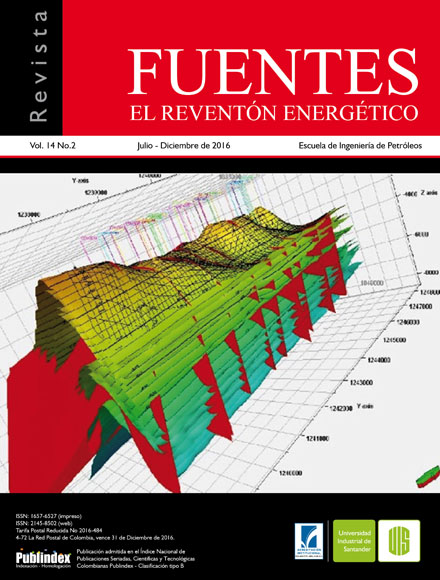Desarrollo de un modelo de flujo vertical en tuberías para crudos extrapesados considerando el fénomeno de foamy oil
Publicado 2017-01-30
Cómo citar
Derechos de autor 2016 Fuentes, el reventón energético

Esta obra está bajo una licencia internacional Creative Commons Atribución 4.0.
Resumen
Los fluidos tipo “Foamy Oil” tienen una gran particularidad en la dinámica de fases ante la variación de la presión y temperatura en el sistema. El presente artículo plantea una aproximación a partir de dos fenómenos: Nucleación y Coalescencia. El primero permite establecer la geometría que regula la dinámica de las fases y el segundo las condiciones a partir de las cuales la fase gaseosa empieza a fluir como fase independiente, esto es, las condiciones a partir de las cuales la geometría esférica de las burbujas de gas cambia a una geometría regulada por la burbuja de Taylor. El punto de encuentro de los dos se define a partir del modelo tipo “volúmenes igualados”, por medio del cual se establece el diferencial de presión en términos de la reología del fluido, la cuales se puede expresar de acuerdo al modelo de ley de potencia para fluidos no-newtonianos. La evaluación del fenómeno se realiza en términos probabilísticos para asegurar que la sensibilidad de las variables establezcan los rangos de aplicabilidad y consistencia de los resultados.
Palabras clave: Foamy Oil, Ley de Potencia, Propiedades PVT, Nucleación, Coalescencia.
Descargas
Referencias
- Abou-el-hassan, M.E. Correlations for bubble
- rise velocity correlation, Chemical Engineer
- Communications, Vol. 2, Pág. 243, 1983.
- Akagawa, K., and Sakaguchi, T., “Fluctuation in
- Void Ratio in Two-Phase Flow”, Bulletin, JSME,
- Vol. 9, p. 104-120, 1966.
- ANSYS® CFX-Solver. Release 10.0: Theory, 2010.
- Barnes, H.A., Hutton, J.F. y Walters K., An
- Introduction to Rheology, Elsevier, 1989.
- Bird, R.B. and Stewart, W.E. and Lightfoot, E.N.:
- “Transport Phenomena”, John Wiley and Sons, Inc,
- NYC, 1960.
- Blauer, R.E. and Holcomb, D.L.: “Foam Fracturing
- Shows Success in Gas, Oil Formations,” Oil and
- GasJ. (Aug. 1975) 57-60.
- Blauer, R.E., Mitchell, B.J. and Kohlhaas, C.A.:
- “Determination of Laminar, Turbulent,and
- Transitional Foam Flow Losses in Pipes”, SPE 4885
- presented at the 44th Annual California Regional
- Meeting of the Society of Petroleum Engineers of
- AIME, San Francisco, California, April 4-5, 1974.
- Bonilla, L.F. and Shah, S.N.: “Experimental
- Investigation on the Rheology of Foams”, SPE
- presented at the SPE/CERI Gas Technology
- Symposium held in Calgary, Alberta Canada, April
- -5, 2000.
- Brennen Christopher, Fundamentals of Multiphase
- Flows, California Institute of Technology,
- Cambridge University Press, 2005.
- Calvert, J. R. and K. Nezhati, “A Rheological model
- for a liquid-gas foam,” Int. J. Heat Fluid Flow 7,
- -168 (1986).
- David, A. and Marsden, S.S.: “The Rheology of
- Foam”, SPE 2544 presented at the 44th Annual
- Meeting of the SPE, Denver, CO, September 28,
- Gaddis E.; Vogelpohl A., Bubble formation in
- quiescent liquids under constant flow conditions,
- Chemical Engineer Science, Vol 41, Págs. 97 –
- ; 1986.
- Gardiner, B.S., Dlugogorski, B.Z. and Jameson,
- G.J.: “Prediction of Pressure Losses in Pipe Flow
- of Aqueous Foams”, Industrial and Engineering
- Chemistry Research, 38, p. 1099-1106, May
- Harris, P.C. and Heath, S.J.: “High-Quality Foam
- Fracturing Fluids”, SPE 35600 presented at the
- SPE Gas Technology Symposium held in Calgary,
- Alberta, Canada, April 28 – May 1, 1996.
- Heller, J. P. and M. S. Kuntamukkula, “Critical
- Review of the Foam Rheology Literature,” Ind.
- Eng. Chem. Res. 26, 318-325 (1987).
- Kraus, W.P., Mc Caffrey, W.J., Boyd G.W.;
- Pseudo-Bubble Point Model for Foamy Oils,
- Paper CIM 93-45 presentado en CIM 44th Annual
- Technical Conference of the Petroleum Society of
- CIM, Calgary, Alberta, Mayo 9-12, 1993.
- Mao, Z.S., and Duckler, A.E., “The Motion
- of Bubbles in Vertical Tubes. A Numerical
- Simulation for the Shape and Rise Velocity of
- Taylor Bubbles in Stagnant and Flowing Liquid”,
- Journal of Computational Physics, Vol. 91, pp.
- -160, 1990.
- Princen, H. M.. Rheology of foams and highly
- concentrated emulsions: I. Elastic Properties and
- Yield Stress of a Cylindrical Model System”,
- Journal of Colloid Interface Science, Elsevier
- B.V., Vol 91, Págs. 160-175, 1983.
